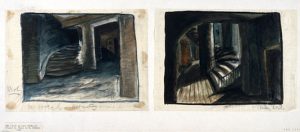30 Researching cultural expression in inter-war Germany by Eleanor Hogan
Historical inquiry in a jigsaw format

“Walter Röhrig, The Idiot (Irrende Seelen), 1921” by Walter Röhrig, Public Domain
| Curriculum context
|
Modern History, Unit 1:Change and Conflict, Area of Study 2 Social and Cultural Change (VCAA, 2020) |
| Historical context
|
Germany from 1919 – 1933 |
| Historical thinking concepts
|
Ask and use historical questions
Establish historical significance Explore historical perspectives Use sources as evidence
|
| Learning intentions
|
Use research skills to learn about a perspective and/or cultural expression present in Germany from 1919 – 1933
Evaluate the significance of events, ideas, individuals and movements that influenced and resisted change Construct arguments about social and cultural continuity and change using sources as evidence |
Activity
This jigsaw activity is done in groups and will involve you researching a perspective and/or cultural expression from Germany 1919 – 1933 but everyone in the group will be researching a different perspective and/or cultural expression. Your information will be presented in a multimedia presentation to your group and your presentations will be marked by the peers in your group using a rubric developed by the group.
Step 1: Choose a focus
Move into home groups and decide which perspective each group member will research. The group or whole class then needs to develop a rubric by deciding on key criteria and achievement standards.
Select a focus for your historical inquiry
Perspectives:
- Jewish community
- Feminists
- LGBTQIA+
- Nazi youth
- Nazi supporter
- Anti-Nazi perspectives
- Romani community
- or another perspective you are interested in researching
Forms of cultural expression:
- Architecture/architects
- Art/artists
- Film/film makers
- Literature/writers
- Music/musicians
- Photos/photographers
- Modernist movements (Expressionism, Bauhaus Movement)
- another cultural expression you are interested in researching
Step 2: Researching
Find other people in the other groups who are doing the same perspective with you and work with them as an expert group. When you have completed your presentation, you will move back to present to your home group. Use the, who, what, when, where, why, how question structure to begin planning historical questions for your historical inquiry.
What if I’m stuck and don’t know where to start researching? Use these questions to help form your base research:
Who contributed to the perspective/cultural expression present in Germany from 1919 – 1933?
Who was influenced by your perspective/cultural expression?
What are the main views of your perspective?
What is your perspective/cultural expression trying to say about life in Germany?
When did your perspective/cultural expression first emerge in Germany? Was there an initial person/group who brought this perspective/cultural expression to Germany?
Why is this perspective/cultural expression important to social, cultural and/or political development of Germany?
Why did you chose to research this perspective/cultural expression? Why is it important to you? What do you think other people should know/learn about this perspective/cultural expression?
Step 3: Designing presentation
Develop a multimedia presentation, remembering your home group will be your audience. See your teacher about how it should be referenced.
Step 4: Presenting and peer feedback
Back on your home groups, take turns to present and use the rubric to provide peer feedback.
Step 5: Discussion
Use the following question to frame your group’s discussion:
To what extent were these perspectives/cultural expressions significant to social, cultural and political change in Germany from 1919 – 1933?
Which perspective/cultural expression was the most significant to the social, cultural and political change in Germany from 1919 – 1933?
Develop an argument in response to one of these questions. Include a contention and supporting evidence.
References
VCAA. (2020). VCE Study Design: History 2022-2026. Victorian Curriculum And Assessment Authority. https://www.vcaa.vic.edu.au/curriculum/vce/vce-study-designs/history/Pages/index.aspx

